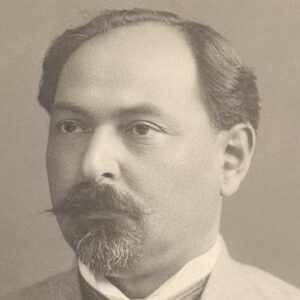Nariman Narimanov was an Azerbaijani revolutionary, politician, and writer in the early twentieth century. He worked as a doctor in his younger years and wrote the popular Azerbaijani revolutionary novel ‘Bahadur and Sona.’ He took part in the Revolution of 1905-1907 while studying medicine and went on to become a renowned leader in a variety of political parties. He continued to work for the Azerbaijani Communist Party even after being detained and exiled from the nation for five years. He became the chair of the Soviet of People’s Commissars in 1920, which eventually contributed to the downfall of Russian sovereignty over Azerbaijan. He went on to lead Soviet Azerbaijan after that. He was the principal opponent of Sergo Ordzhonikidze, a pupil of Joseph Stalin, who desired to join the republics of Azerbaijan, Armenia, and Georgia into the Transcaucasian Federation at the height of his political career.
Childhood and Adolescence
Narimanov was born on April 2, 1870, into a middle-class merchant family of Azerbaijani heritage in Tiflis, Georgia (then part of the Russian empire). In 1890, he graduated from the Transcaucasian Teachers Seminary in Gori, Georgia, with a secondary school diploma.
He was an active author, translator, and dramatist while working as a teacher in the Tiflis district of Gizel-Adjal in 1895. In Turkish, he translated Nikolia Gogol’s satirical drama “The Government Inspector.” The 1896 book ‘Bahadur and Sona’ and the 1899 historical trilogy ‘Nadir-shah,’ as well as a variety of short pieces, were his most well-known self-written works. He studied medicine at Novorossiysk University in Krasnodar Krai from 1902 to 1908. He earned his medical degree from Odessa University in the Ukraine in 1908.
Career of Nariman Narimanov
While practicing medicine in 1905, Narimanov joined the Russian Social Democratic Labour Party, also known as the Bolsheviks, and became a participant in the 1905 Revolution. In 1909, he was imprisoned and sentenced to five years in exile as the leader of the Isheyun-Asheyun, a Persian socialist democratic party.
He continued to organize the Azerbaijan Communist Party until 1913, despite his incarceration and exile. He was elected chairman of the Hummet, the Azerbaijani Social Democratic Political Party, after the Great October Socialist Revolution in 1917, which would later become the Communist Party of Azerbaijan. In 1918, he was named People’s Commissar of National Economy by the Baku Soviet Party.
He departed Baku after the Soviet regime crumbled in 1918 and became the People’s Commissariat of Foreign Affairs for Soviet Russia.
Later, he was promoted to the Commissariat of National Affairs as the Deputy People’s Commissar.
He was elected a candidate to the RKP (Russian Communist Party of Bolsheviks) Central Committee in April 1923. Following a disagreement with Sergo Ordzhonikidze, a follower of Joseph Stalin, he was demoted to a low-level position in Moscow under the pretence of a promotion. He was in charge of relations between Iran and Afghanistan at the time.
Major Projects of Nariman Narimanov
He was elected Chairman of the Azerbaijani Revolutionary Committee in 1920, and later became Chairman of the Azerbaijani Soviet Republic’s Council of People’s Commissars. He was the head of the Soviet Azerbaijani government from May 1920 to May 1921.
He was a Soviet delegate to the Genoese Conference in 1922. He was elected head of the Union Council of the Transcaucasian Federation, which includes Azerbaijan, Georgia, and Armenia, in the same year.
He was elected chairman of the USSR by the Central Executive Committee on December 30, 1922, a position he maintained until March 19, 1925.
Personal History and Legacy
Gulsum, his wife, was his life partner. Narimanov died on March 19, 1925, of a heart attack, leaving behind his wife Gulsum and small son Najaf. His remains were interred at Moscow’s Kremlin Wall Necropolis. Thousands of people attended his funeral, which was proclaimed three days of mourning by the Russian government.
His son Najaf enlisted in the Red Army in 1938 and attended Kiev’s Higher Military Radio Technical Engineering School until 1940. During the combat on the Eastern Front, he was killed while acting as the Tank Division Commander (World War II).
Narimanov, along with his fellow Hummet nationalists, were denounced during the Soviet political turbulence known as The Great Purge in the 1930s. Joseph Stalin’s legacy was renewed and glorified after his death in 1953. Azerbaijanis have erected memorials to him at Sumgayit, Baku, and Ganja, as well as a roadway at Baku’s Azerbaijan Medical University. He also has a memorial in Georgia.
Because he is viewed by the people as a true defender of Azerbaijan, Narimanov’s monument in Baku is one of the few political statues left standing following the dissolution of the Soviet Union in 1991.
Estimated Net Worth
Nariman is one of the wealthiest politicians and one of the most well-known. Nariman Narimanov’s net worth is estimated to be $1.5 million, according to Wikipedia, Forbes, and Business Insider.
Trivia
Before entering politics, Narimanov assisted in the construction of Gizel-first Adjal’s public library.
His death, according to revolutionary Leon Trotsky, was the “second worst loss for the Eastern World.”


